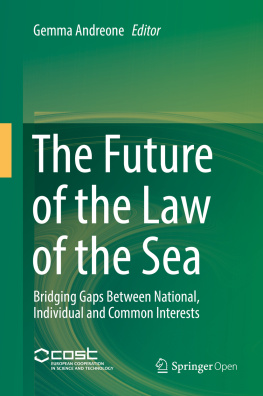Introduction
A fresh look at the latest satellite data from 2002 and 2014 shows that seas are rising by around 1.4 mm a year due to thermal expansion rather than 0.71 mm as was expected.
The reality of climate change and sea level rise does not only have geographical impacts. It may also generate legal implication of changing baselines, which in turn influences the outer limits of maritime zones. The potential submergence of important base points may potentially lead to the loss of maritime jurisdiction subject to maritime claims and to the loss of jurisdictional rights over valuable resources within these maritime spaces. This could consequently have disastrous economic consequences.
It is important to recall that a coastal States maritime claims to maritime zonesterritorial sea, contiguous zone, exclusive economic zone and continental shelf under the United Nations Convention on the Law of the Sea (UNCLOS)are measured from baselines except for one of the situations where the outer limits of continental shelf exceed 200 nautical miles.
Moreover, baselines are quite important to the delimitation of boundaries. In the bilateral delimitation of maritime boundaries, baselines form the starting point in delimitations between adjacent and opposite States with overlapping claims to maritime areathe role of baselines.
However, baselines are facing sea level rise effects and at the same time the silence of UNCLOS to the question whether these baselines and therefore maritime zonesor one of themshift or remain stable and effective. Case law on maritime delimitation provides little responses.
This article examines the potential effects of sea level rise on baselines, the outer limits of maritime zones, and maritime boundary. It will discuss in the first section the question on how the law of the sea can adapt to sea level rise and what measures can be adopted to address the implications of sea level rise on baselines and the establishment of maritime zones. Therefore, the second section of this chapter will focus on the analysis of the effects of sea level rise on baselines from which the maritime limits and boundaries are determined. The third section will provide the potential legal responses to mitigate the effects of sea level rise regarding baseline alteration and disappearance. It tries to answer the question of whether baselines should be ambulatory or permanently fixed. The result of this study will be presented in the conclusion in the fourth section.
Legal Implication of Sea Level Rise on Baselines from Which Maritime Limits and Boundaries Are Determined
This section mainly discusses the legal framework of maritime zones and the current legal regime of baselines to contextualize the study before analyzing the legal implication of sea level rise on baselines, which in turn influences the outer limits of maritime zones.
2.1 General Description of Maritime Zones
According to the United Nations Convention of 10 December 1982 on the Law of the Sea (UNCLOS), maritime zones can be divided mainly into six areas as follows. The internal waters are located on the landward side of the baselines and comprise the maritime waters adjacent to the land territory of the coastal State (article 8 1 UNCLOS); the territorial sea is adjacent to the internal waters, and it measures 12 nautical miles from the baseline (articles 2 1 and 3 UNCLOS); the contiguous zone measured 24 nautical miles from the baseline where coastal State has, notably, policing powers in relation to its customs, fiscal, sanitary and immigration laws, and regulations (article 33 UNCLOS); the exclusive economic zone is 200 nautical miles wide (article 57 UNCLOS) where coastal State has sovereign rights on this zone in respect to environmental protection, scientific research, exploration, and the use of natural resources (article 56 UNCLOS). The continental shelf is the prolongation of the coastal States land territory submerged for 200 miles from the baselines when the outer edge of the continental margin is less or up to 350 nautical miles (or 100 nautical miles from the 2500 m isobath) if it is wider (article 76 UNCLOS). However, since the coastal States right to outer limits of continental shelf relies not only on the 200 nautical miles rule but also on the natural prolongation criterion, it implies that the outer limits of the continental shelf must not always be measured from baselines. The coastal State has sovereign rights over this area in respect to the exploration and exploitation of natural resources (article 77 1 UNCLOS). Finally, the high seas are not subject to the States sovereignty and are located beyond the external limit of the EEZ (as a maximum of 200 miles from the baselines) (article 86 UNCLOS). The outer limit of all these zones are determined and delimited from baselines except for one of the situations where outer limits of continental shelf exceed 200 nautical miles.
2.2 Each Maritime Zone Is Measured from Lines Joining Appropriate Points on Land: Baselines
UNCLOS establishes the legal framework of baselines. However, in some cases, it appears that a distinction between baselines serving for measuring the limits of the maritime zones and baseline serving for establishing maritime boundary can be drawn.
2.2.1 The Establishment of Baselines Under UNCLOS: Relevant Provisions
The establishment of baselines is a fundamental operation for a coastal State wishing to have jurisdiction over maritime zones adjacent to the continental coasts. These lines are the basis of the coastal States appropriation of the maritime zones in the sense that it constitutes the lines from which maritime zones are measured. Consequently, baselines are the starting line of the outer limits of maritime zones, and then the significant change on these lines will accordingly affect the jurisdiction of outer limits of maritime zones. They aim to correct the curves of the coast and to prevent their reproduction by enveloping the coast as an envelope line.
There are different types of baselines (normal baselines, straight baselines and other bay closing lines, straight line across the mouth of the river) that mainly depend on the general configuration of the coast. A State unilaterally determines the base points that are relevant according to UNCLOS. This national operation
Normal Baselines
The relevant regulation concerning baselines was included in the Geneva Convention 1958 drawn also according to UNCLOS, including article 6 (reefs), article 8 (internal waters), article 9 (mouths of rivers), article 13 (low-tide elevations). It appears that the coastal State would try to choose the lowest line to establish its baseline far from the coast seaward.
A reference to the method of drawing baselines is made in article 14 of UNCLOS, which underlines that the coastal State may determine baselines in turn by any of the methods provided for in the foregoing articles to suit different conditions. Therefore, only States have the right to choose the reference level of its low-water line, and it is submitted to any evaluation. However, a straight baseline has a particular regime.
Straight Baselines
Straight baselines are drawn where a coastline is deeply indented and cut into, or in the presence of a fringe of islands along the coast in its immediate vicinity. They are drawn by joining the appropriate base points on land in accordance with article 7(1) of UNCLOS.










